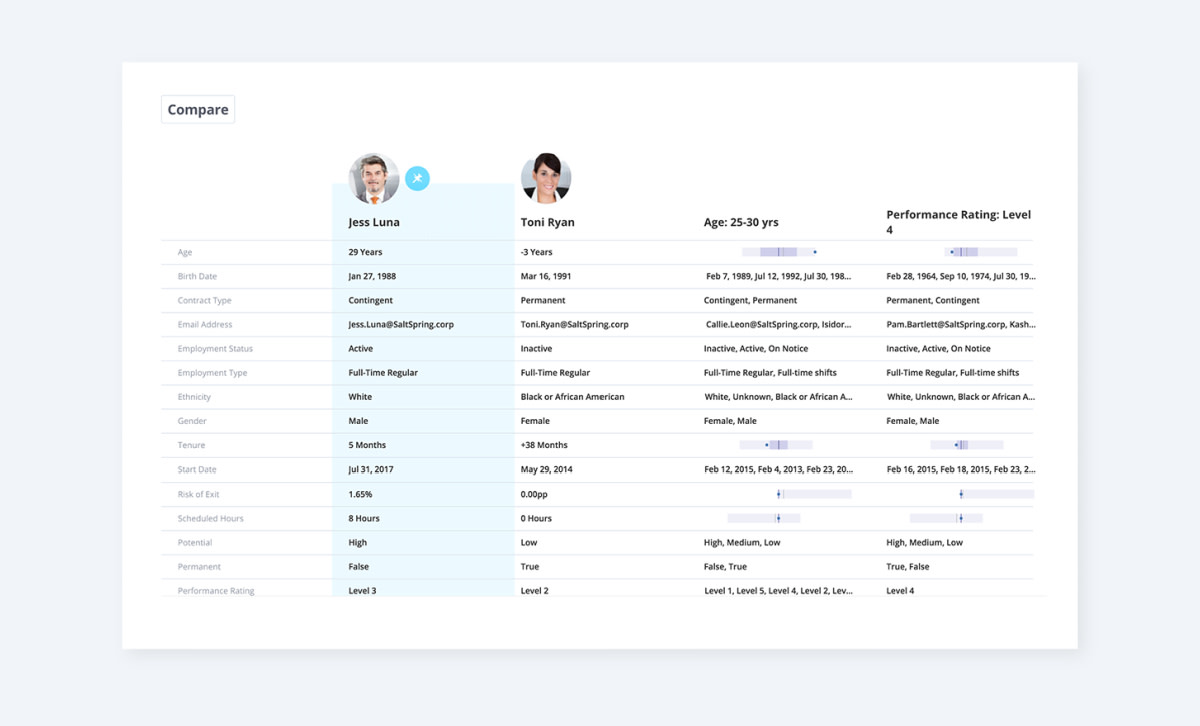How To Use Cohort Analysis for Better Workforce Decisions
Use data-driven cohort analysis in these common scenarios to get the insights you need to make better workforce decisions.

Talking compensation and promotions with your employees can be a tricky business, yet many managers make these costly (and sometimes time-sensitive) people decisions based on hallway conversations and gut feel.
Intuition — a mental “shortcut” — is the result of two hardwired processes (pattern recognition and emotional tagging), which frequently lead to cognitive errors. As a result of “going with your gut”, even the best, most experienced business leaders can make poor judgement calls about individuals.
Without analytics to back up these decisions, it’s impossible to tell if an employee is being rewarded fairly.
Instead of accepting an intuition-based decision, consider performing a data-driven cohort analysis, where you look at each employee’s detailed work records and perform comparisons against similar employees and employee groups. This will not only give you a better picture of what the rewards model at your organization looks like, but also enable your managers to make better judgement calls based on evidence.
Here are some common scenarios where data-driven cohort analysis can aid in making better decisions:
Improving compensation reviews
When it comes to this annual exercise, you need to start by asking: how does this employee compare to their peers and employee group? This will help you determine whether you are paying this person fairly within your own compensation framework.
To fully understand the situation, compare the person against:
Direct peers – The first and most relevant comparison is to the people who perform the same role, at the same level, and in a similar geography. By comparing the employee to these people you can establish a clear picture of whether or not the person’s situation is unique: Is she a higher performer than others? Is she rewarded fairly compared to these people?
His or her employee group – The individual may be above and below specific direct peers; however, it is also important to understand whether she is above or below the median for her peers when they are considered as a group. For example, if she is below the median on pay and above the median on performance for the group, then the data suggests she could be worth the additional salary.
Similar employees across the business – Finally, compare the individual to people who are similar to the employee but maybe work in different geographies or different functions. This comparison helps you determine how well she is being compensated within her existing pay band. Where does she sit in the distribution? Are there many examples of people who are at the higher end of the pay band that would set a precedence for a compensation increase?
Once you have a clear picture of where each employee sits, you should use the same approach to assess data from their entire lifecycle at your organization: what it cost to hire them, their performance and contributions during their tenure, and their future potential.
With all these data points in hand, you can be confident that any changes made to an employee’s compensation structure more accurately reflect their history with the company.

Negotiating counter-offers
It’s essential that you turn to your workforce data when an employee comes to you with a competing offer. Perform the same analysis as you would with the compensation review to determine how to handle the situation.
If, after analyzing the above areas, you determine that your organization is not paying the individual fairly, your next course of action is clear: you need to counter-offer. However, if you are indeed paying the individual fairly relative to other people within the organization, then you must return to your data and now assess that individual’s current and potential value.
Allison McConville, Visier’s VP of Human Resources, provides more information on using analytics in counter-offer negotiations (as well as other compensation scenarios) in this blog post.
Instead of accepting an intuition-based decision, consider performing a data-driven cohort analysis, where you look at each employee’s detailed work records and perform comparisons against similar employees and employee groups
Assessing promotions
Without data, assessing if an employee is ready for a promotion can turn into a narrative about who leaders perceive to be the most promising — and all of us are prone to bias.
Promotions, especially if they’re part of a risk-mitigating process like succession planning, work best if it involves an evidence-based approach. Leadership potential should be assessed on performance data, number of past promotions and how close together these events occurred, and learning and development achievements. Look at all these factors for each internal candidate to determine who one truly has the best chance of succeeding in their new role.
Don’t rely on your HRMS for cohort analysis
While organizations collect more employee data than ever before, this data is locked in HR management systems that were never designed for analysis. These systems were created to support business processes, such as allowing managers to approve time off, request a new position, or provide performance feedback. Yet business processes are what happens after the people decisions have already been made.
To be successful in leveraging that data for insights, it’s critical that you and the business leaders you support have a way to mine for insights quickly and correctly so you can make the best calls for both your organization and employees. Meaningful analysis of employees must be on demand, comparative, and reflect that employees develop and change over time.
Working with data can be daunting for many, but people strategy platforms – especially ones that provide instant side-by-side employee comparison capabilities – make workforce analytics more accessible so it’s faster and easier to get the insights needed for all your important talent discussions.



